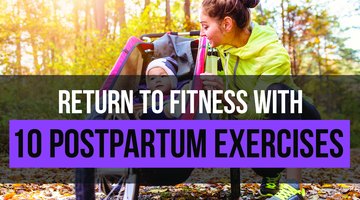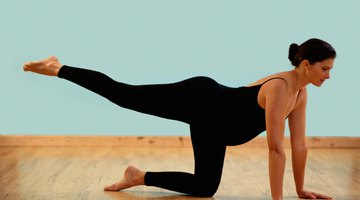How to Get Rid of the Belly Bulge After a C-Section
Births by C-section are becoming more common, and so are the new moms who struggle to get rid of the post-C-section belly.
While all new mothers have some belly fat that sticks around, the surgical incision creates a C-section shelf that makes the bulge more pronounced. Unfortunately, that makes it more difficult to get rid of — but not impossible. When you're ready, exercising and maintaining a healthy diet will help you burn fat and flatten your tummy.
Care for Your Post C-Section Belly
The recovery after a C-section is longer than for a vaginal birth.
The abdominal muscles have been have been cut in order to extract the baby and then sewn up again. They must have time to heal before you engage in vigorous activity.
Cardio exercise and lifting heavy objects is definitely out of the picture for at least the first six weeks of recovery. Your doctor will assess your healing progress at your follow-up appointments. When she gives you the green light, you can start to gradually add exercise according to her recommendations.
For this reason, you can't rush into burning off the belly fat right away.
During this time, you have to be patient and focus on making changes to your diet that can help you reduce your caloric intake. More on that later.
Get Up and Get Moving

5 Methods to Get Your Stomach in Shape After C-Section Damage
Learn More
Your doctor has cleared you for exercise, and you're raring to go.
But your doctor has probably told you that light exercise is your limit right now. You may be anxious to burn off that belly fat, but it's important to keep it low-key right now.
So just get moving. Any physical activity burns calories: vacuuming, walking around the house with your baby instead of cuddling on the couch, walking up and down the stairs to the laundry room, parking your car a little farther from the grocery store and taking the stairs instead of the escalator or elevator.
Make a conscious effort to move more throughout the day and you'll get the belly fat-burning ball rolling.
Read more: Post C-Section Abs Exercises
Start a Walking Program
Walking is a weight-bearing form of exercise, which means that, in addition to burning calories, it builds muscle and bone strength. Plus, it is a great way to get you and baby outside the four walls of your house to breathe fresh air and get some sunshine. How many calories you'll burn depends on how quickly you walk and for how long. It also depends on your body weight (which you don't have to reveal to anyone).
According to Harvard Health Publishing, a 155-pound woman can burn 149 calories walking at a pace of 3.5 miles per hour for 30 minutes. If she increases her pace to 4 miles per hour, she'll burn 167 calories. Walking at an even faster pace of 4.5 miles per hour, she'll burn 186 calories.
Pushing a stroller will add a little more to these calorie counts. Start out slow and, once you're able, increase your pace a little each time you go out. When you're comfortable walking on level terrain at a steady pace, find some hills to climb. That will increase the challenge and the calorie burn.
Tips
There's no such thing as spot reduction. In order to lose belly fat, you have to lose total body fat, some of which will come from your belly. Doing lots of abs after C-section also won't do anything to burn belly fat, although it will give you strength and muscle definition that you'll see once you get rid of your C-section pooch.
Try Other Cardio Activities

7 Strategies for Fitting in Exercise With a Newborn Baby
Learn More
At some point, you may want to add other activities and increase the intensity.
You might be able to up your walking pace to a jogging pace, if you're having no pain and no bleeding from the incision. That is up to you and your doctor to decide.
If not, you can find other low-impact activities that burn more calories than walking, work different muscles and add variety. Many of them also involve getting out of the house and provide the opportunity for you to get a little "me time."
Give these low-impact activities a try:
- Using the elliptical machine
- Rowing
- Riding a stationary bike
- Riding your bike outdoors
- Using the stair climber machine
- Taking a spinning class (at your own pace)
- Taking a water aerobics class
- Taking a gentle flow yoga class (using suitable modifications if necessary)
Find a few activities you like to do and try to do one each day.
Build Strength and Muscle
Athletic is the new skinny.
Don't strive to just lose the fat, aim to build lean muscle mass as well. The more muscle mass you have, the more calories you'll burn throughout the day, even when you're not doing anything.
This is because muscle mass is more metabolically active than fat mass, about four times more active for an individual with 20 percent body fat, according to Paige Kinucan and Dr. Len Kravitz of the University of New Mexico. Your body burns calories to build and maintain muscle, while excess fat just sits around doing nothing.
Start With Body Weight Exercises
Where you start depends on where you are in the healing process; again, you should defer to your doctor.
Body weight exercises are a great entry — or reentry — to strength training. Exercises can be as simple as wall pushups and bridges on your living room floor.
Pre- and post-natal exercise specialist Jessie Mundell recommends these exercises when first getting back to strength training:
- Side plank
- Squats
- Split squats
- Band pull-aparts
- TRX inverted row
Once you've built a foundation of strength, you can start to add new exercises and more weight.
Avoid Certain Exercises
There are certain exercises that aren't recommended when you're first resuming resistance training. According to Mundell, these include:
- Crunches, situps, leg raises and front planks
- Step-ups
- Heavy overhead presses
- Heavily weighted exercises
- Any exercise that puts direct downward pressure on the pelvic floor, such as a barbell back squat
You should also avoid plyometric exercises involving jumping, as well as high-intensity circuit-training workouts.
Rein in Your Diet
Your diet plays a starring role in how easily and quickly you can ditch the C-section pooch.
Lots of factors during your recovery, including stress and fatigue, can lead you to eat more than you normally would. This isn't good at any time, but it's especially detrimental when you're not getting a lot of physical activity.
Eat Clean Foods
Stick to eating foods as close to their natural state as possible — fresh fruits and vegetables, lean protein, whole grains, nuts and seeds and, in moderation, dairy. Eschew most foods that come in a box or bag or on a tray.
Don't Eat Sugar
It's tempting to reach for a sugary snack or soda when you're kicking around the house all day. But this will only add to your C-section shelf.
Don't even keep those kinds of foods in the house. Out of sight equals out of mind.
Reduce Your Carb Intake
You don't need as many carbs if your activity level is low.
Increase your protein intake and decrease your carb intake until you're able to increase your activity level. Cut carbs mainly from sources like sweets, breads, refined-grain products and high-sugar fruits like bananas.
Related Articles
- Healthline: 5 Exercises to Help With Your C-Section Recovery
- National Institutes of Health: Exercise for Your Bone Health
- Harvard Health Publishing: Calories Burned in 30 Minutes for People of Three Different Weights
- University of New Mexico: Controversies in Metabolism
- The PTDC: Returning to Exercise After C-Section Recovery (for Trainers)









